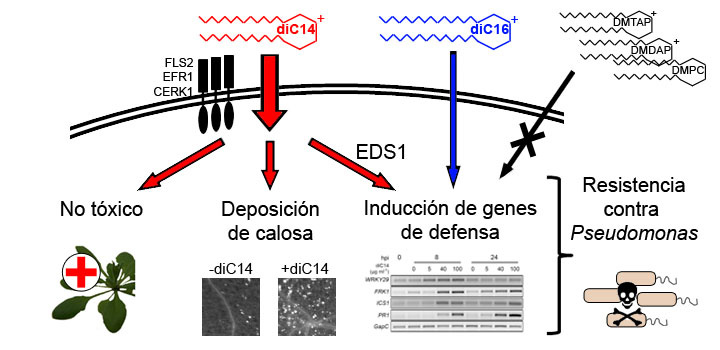Cambiagno DA et al. 2015, Mol. Plant. Pathol.
Natural and synthetic elicitors have contributed significantly to the study of plant immunity. Pathogen-derived proteins and carbohydrates that bind to immune receptors, allow the fine dissection of certain defence pathways. Lipids of a different nature that act as defence elicitors, have also been studied, but their specific effects have been less well characterized, and their receptors have not been identified. In animal cells, nanoliposomes of the synthetic cationic lipid 3-tetradecylamino-tert-butyl-N-tetradecylpropionamidine (diC14) activate the TLR4-dependent immune cascade. Here, we have investigated whether this lipid induces Arabidopsis defence responses. At the local level, diC14 activated early and late defence gene markers (FRK1, WRKY29, ICS1 and PR1), acting in a dose-dependent manner. This lipid induced the salicylic acid (SA)-dependent, but not jasmonic acid (JA)-dependent, pathway and protected plants against Pseudomonas syringae pv. tomato (Pst), but not Botrytis cinerea. diC14 was not toxic to plant or pathogen, and potentiated pathogen-induced callose deposition. At the systemic level, diC14 induced PR1 expression and conferred resistance against Pst. diC14-induced defence responses required the signalling protein EDS1, but not NDR1. Curiously, the lipid-induced defence gene expression was lower in the fls2/efr/cerk1 triple mutant, but still unchanged in the single mutants. The amidine headgroup and chain length were important for its activity. Given the robustness of the responses triggered by diC14, its specific action on a defence pathway and the requirement for well-known defence components, this synthetic lipid is emerging as a useful tool to investigate the initial events involved in plant innate immunity.
Autores: Cambiagno DA, Lonez, C, Ruysschaert JM, Alvarez ME.
Artículo: Cambiagno DA et al, Mol. Plant. Pathol. 2015 Feb 26. doi: 10.1111/mpp.12252



